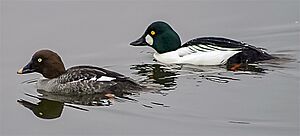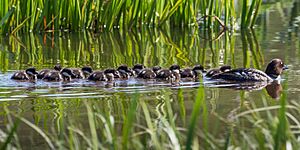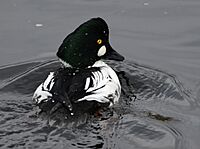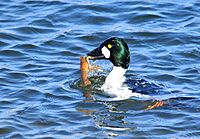Common goldeneye facts for kids
Quick facts for kids Common goldeneye |
|
|---|---|
 |
|
| Adult male | |
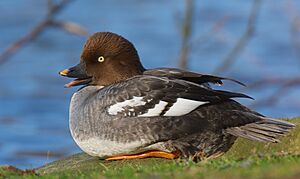 |
|
| Adult female | |
| Conservation status | |
| Scientific classification | |
| Genus: |
Bucephala
|
| Species: |
clangula
|
| Subspecies | |
(Eurasian goldeneye)
(American goldeneye) |
|
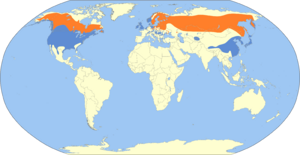 |
|
| Synonyms | |
|
|
The common goldeneye (Bucephala clangula) is a cool medium-sized sea duck. It's part of a group of ducks called goldeneyes. Its name comes from the Ancient Greek words boukephalos, meaning "bullheaded," because of its round head. The second part of its name, clangula, comes from Latin and means "to resound," perhaps because of the sound its wings make when it flies.
Common goldeneyes are known for being quite bold and protective of their space. They also have amazing courtship displays to attract a mate!
Contents
What Does a Common Goldeneye Look Like?
Common goldeneyes are easy to spot with their bright golden-yellow eyes. This is how they got their name!
Adult males are about 45 to 51 centimeters (18 to 20 inches) long. They weigh around 1 kilogram (2.2 pounds). Males have a dark head that shines with a greenish color. They also have a clear white circle right below their eye. Their back is dark, and their neck and belly are white.
Adult females are a bit smaller, usually 40 to 50 centimeters (16 to 20 inches) long. They weigh about 800 grams (1.8 pounds). Females have a brown head and a mostly gray body. Both males and females have orange-yellow legs and feet. Their wingspan, or how wide their wings stretch, is about 77 to 83 centimeters (30 to 33 inches).
There are two main types, or subspecies, of common goldeneyes. One lives in Eurasia (Europe and Asia), and the other lives in North America. The North American type has a slightly longer and thicker bill.
Where Do Goldeneyes Live and How Do They Raise Their Young?
Common goldeneyes like to live in boreal forests, which are cold, northern forests. They can be found near lakes and rivers in places like Canada, the northern United States, Scotland, Scandinavia, and northern Russia.
These ducks are migratory. This means they fly to warmer places for winter. They often spend the colder months in protected coastal waters or large inland lakes.
Goldeneyes are special because they nest in holes inside large trees. These holes are often made by broken branches or by large woodpeckers. They like to come back to the same nesting spot every year. Luckily, they are also happy to use nest boxes that people put out for them!
The female goldeneye does all the work of sitting on the eggs, which takes about 28 to 32 days. The male usually leaves her about a week or two after she starts incubating. The ducklings stay in the nest for only about a day or two after hatching.
Sometimes, a female goldeneye might lay her eggs in another goldeneye's nest. This is called brood parasitism. As the young ducklings grow, they often mix with other families or are left by their mothers. Young goldeneyes can fly when they are about 55 to 65 days old.
What Do Goldeneyes Eat and Who Are Their Predators?
Common goldeneyes are diving birds. This means they dive underwater to find their food.
All year round, their diet mainly includes crustaceans (like small crabs or shrimp) and aquatic insects. They also eat molluscs (like snails). When they are nesting, insects are their favorite food. During migration and winter, they eat more crustaceans. Sometimes, they might also eat fish eggs or water plants if they are available.
Goldeneyes can be hunted by larger birds like hawks, owls, and eagles. Female goldeneyes and their ducklings can also be prey for animals like bears, weasels, mink, and raccoons. Even some birds like northern flickers and American red squirrels have been known to prey on young goldeneyes.
How Are Goldeneyes Protected?
The common goldeneye is part of an important agreement called the Agreement on the Conservation of African-Eurasian Migratory Waterbirds (AEWA). This agreement helps protect birds that migrate across Africa and Eurasia.
In the past, many common goldeneyes were hunted. However, efforts are being made to protect them. Their homes, both where they breed and where they spend the winter, have sometimes been harmed by things like clearing land or pollution. But overall, the common goldeneye is not currently considered an endangered species.
Images for kids
-
Goldeneyes flying over the Rideau River in Ottawa, Ontario.
-
A goldeneye with a northern crayfish it caught.



